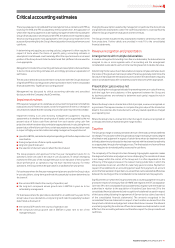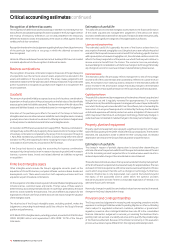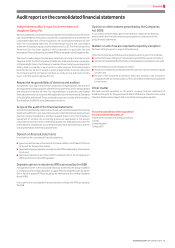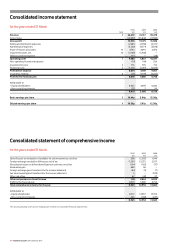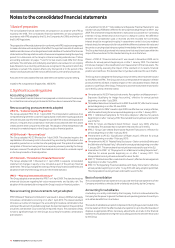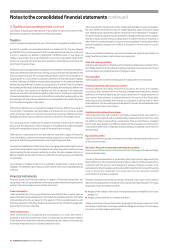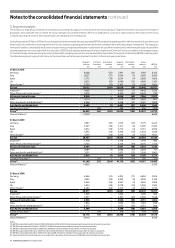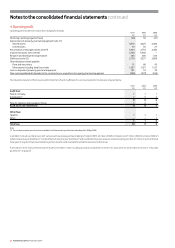Vodafone 2010 Annual Report Download - page 83
Download and view the complete annual report
Please find page 83 of the 2010 Vodafone annual report below. You can navigate through the pages in the report by either clicking on the pages listed below, or by using the keyword search tool below to find specific information within the annual report.
Financials
Vodafone Group Plc Annual Report 2010 81
Foreign currencies
The consolidated financial statements are presented in sterling, which is the
parent Company’s functional and presentation currency. Each entity in the Group
determines its own functional currency and items included in the financial
statements of each entity are measured using that functional currency.
Transactions in foreign currencies are initially recorded at the functional currency
rate prevailing at the date of the transaction. Monetary assets and liabilities
denominated in foreign currencies are retranslated into the respective functional
currency of the entity at the rates prevailing on the end of reporting period date.
Non-monetary items carried at fair value that are denominated in foreign currencies
are retranslated at the rates prevailing on the initial transaction dates. Non-monetary
items measured in terms of historical cost in a foreign currency are not retranslated.
Changes in the fair value of monetary securities denominated in foreign currency
classified as available-for-sale are analysed between translation differences and
other changes in the carrying amount of the security. Translation differences are
recognised in the income statement and other changes in carrying amount are
recognised in equity.
Translation differences on non-monetary financial assets, such as investments in
equity securities, classified as available-for-sale are reported as part of the fair value
gain or loss and are included in equity.
For the purpose of presenting consolidated financial statements, the assets and
liabilities of entities with a functional currency other than sterling are expressed in
sterling using exchange rates prevailing on the end of reporting period date. Income
and expense items and cash flows are translated at the average exchange rates for
the period and exchange differences arising are recognised directly in equity. On
disposal of a foreign entity, the cumulative amount previously recognised in equity
relating to that particular foreign operation is recognised in profit or loss.
Goodwill and fair value adjustments arising on the acquisition of a foreign operation
are treated as assets and liabilities of the foreign operation and translated accordingly.
In respect of all foreign operations, any exchange differences that have arisen before
1 April 2004, the date of transition to IFRS, are deemed to be nil and will be excluded
from the determination of any subsequent profit or loss on disposal.
The net foreign exchange gain recognised in the consolidated income statement is
£35 million (2009: £131 million loss, 2008: £373 million gain).
Research expenditure
Expenditure on research activities is recognised as an expense in the period in which
it is incurred.
Post employment benets
For defined benefit retirement plans, the difference between the fair value of the plan
assets and the present value of the plan liabilities is recognised as an asset or liability
on the statement of financial position. Scheme liabilities are assessed using the
projected unit funding method and applying the principal actuarial assumptions at
the end of reporting period date. Assets are valued at market value.
Actuarial gains and losses are taken to the statement of comprehensive income
as incurred. For this purpose, actuarial gains and losses comprise both the effects
of changes in actuarial assumptions and experience adjustments arising because
of differences between the previous actuarial assumptions and what has
actually occurred.
Other movements in the net surplus or deficit are recognised in the income
statement, including the current service cost, any past service cost and the effect of
any curtailment or settlements. The interest cost less the expected return on assets
is also charged to the income statement. The amount charged to the income
statement in respect of these plans is included within operating costs or in the
Group’s share of the results of equity accounted operations as appropriate.
The Group’s contributions to defined contribution pension plans are charged to the
income statement as they fall due.
Revenue from interconnect fees is recognised at the time the services are performed.
Revenue from data services and information provision is recognised when the Group
has performed the related service and, depending on the nature of the service, is
recognised either at the gross amount billed to the customer or the amount
receivable by the Group as commission for facilitating the service.
Customer connection revenue is recognised together with the related equipment
revenue to the extent that the aggregate equipment and connection revenue does
not exceed the fair value of the equipment delivered to the customer. Any customer
connection revenue not recognised together with related equipment revenue is
deferred and recognised over the period in which services are expected to be
provided to the customer.
Revenue for device sales is recognised when the device is delivered to the end
customer and the sale is considered complete. For device sales made to
intermediaries, revenue is recognised if the significant risks associated with the
device are transferred to the intermediary and the intermediary has no general right
of return. If the significant risks are not transferred, revenue recognition is deferred
until sale of the device to an end customer by the intermediary or the expiry of the
right of return.
In revenue arrangements including more than one deliverable, the arrangements are
divided into separate units of accounting. Deliverables are considered separate units
of accounting if the following two conditions are met: (1) the deliverable has value to
the customer on a stand-alone basis and (2) there is evidence of the fair value of the
item. The arrangement consideration is allocated to each separate unit of accounting
based on its relative fair value.
Commissions
Intermediaries are given cash incentives by the Group to connect new customers and
upgrade existing customers.
For intermediaries who do not purchase products and services from the Group, such
cash incentives are accounted for as an expense. Such cash incentives to other
intermediaries are also accounted for as an expense if:
the Group receives an identifiable benefit in exchange for the cash incentive that
is separable from sales transactions to that intermediary; and
the Group can reliably estimate the fair value of that benefit.
Cash incentives that do not meet these criteria are recognised as a reduction of the
related device revenue.
Inventory
Inventory is stated at the lower of cost and net realisable value. Cost is determined
on the basis of weighted average costs and comprises direct materials and, where
applicable, direct labour costs and those overheads that have been incurred in
bringing the inventories to their present location and condition.
Leasing
Leases are classified as finance leases whenever the terms of the lease transfer
substantially all the risks and rewards of ownership of the asset to the lessee. All other
leases are classified as operating leases.
Assets held under finance leases are recognised as assets of the Group at their fair
value at the inception of the lease or, if lower, at the present value of the minimum
lease payments as determined at the inception of the lease. The corresponding
liability to the lessor is included in the statement of financial position as a finance
lease obligation. Lease payments are apportioned between finance charges
and reduction of the lease obligation so as to achieve a constant rate of interest
on the remaining balance of the liability. Finance charges are recognised in the
income statement.
Rentals payable under operating leases are charged to the income statement on a
straight line basis over the term of the relevant lease. Benefits received and receivable
as an incentive to enter into an operating lease are also spread on a straight line basis
over the lease term.


